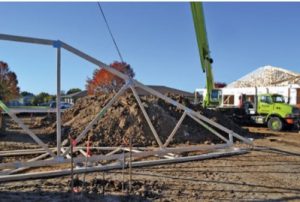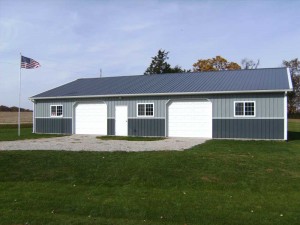My departed ex-father-in-law Carl was a successful hop farmer in the Willamette Valley of Oregon. He and his brother each owned four-passenger Cessna aircraft, and had them in individual hangars on Carl’s farm.
 Carl’s well-manicured grass strip was one of over 14,000 private airstrips in the United States. While many of these are ancillary to farms (face it, farms often have the available space), more and more neighborhoods are being developed around private runways.
Carl’s well-manicured grass strip was one of over 14,000 private airstrips in the United States. While many of these are ancillary to farms (face it, farms often have the available space), more and more neighborhoods are being developed around private runways.
A problem which keeps popping up among folks planning to build residential airpark homes is the size of the hangar and the related building code or fire department regulations. The question usually occurs when building plans are submitted for a structure which includes a hangar of more than 2000 square feet. The plans frequently are rejected or, at the very least, the agency providing the building permit requires the structure to meet commercial construction code limitations. These can include a wide variety of restrictions including requirements for fire retardant interiors, sprinkler systems, explosion proof electric outlets, locations of electrical outlets and much more.
The International Building Code (IBC) addresses specifically requirements for residential hangars (keep in mind, individual permit issuing jurisdiction may amend or waive some or all of these requirements). In order to be considered as a residential airplane hangar, the hangar must meet all three of these criteria:
1) Must be an accessory building constructed on one or two family residential property.
2) Be less than 2,000 square feet
3) Less than 20 feet in height
If not meeting the criteria of a residential hangar, the hangar shall be constructed as a Group S-2 building, which would be for low-hazard storage.
If attached to a dwelling, the hangar shall be separated by walls having a fire-resistance rating of not less than 1-hour. Such separation shall be continuous from the foundation to the underside of the roof and shall be un-pierced except for doors leading to the dwelling unit. Openings from the hangar into a room used for sleeping purposes are not permitted. What you can do is to have the door from the hangar open into a general purpose room, a kitchen, or a hallway. Those areas can then have a doorway into a sleeping room. These requirements are similar to those of an attached residential garage.
Doors into the dwelling unit which separate the dwelling unit from the residential aircraft hangar must comply with the following: Equipped with self-closing devices, ¾ hour rated assembly, and a minimum 4” noncombustible raised sill.
If a detached building, the hangar shall require a 1-hour fire-resistance-rated exterior wall if fire separation distance is less than 3 feet from the property line or any other building on the same property.
A hangar shall provide two means of egress. Only one door into the dwelling shall be considered as meeting one of the two means of egress. Most jurisdictions do not accept the hangar door itself as a means of egress.
A minimum of one listed smoke alarm shall be installed within the hangar and shall be interconnected into the residential smoke alarm or other sounding device which will be audible in all sleeping areas of the dwelling. This requirement is applicable to attached and detached residential hangars.
Mechanical and plumbing systems installed within the hangar shall be independent of the systems installed within the dwelling. Building sewer lines may connect outside the structures.
Pole (post frame) buildings make for ideal residential airplane hangars as they allow for large clearspans, are quickly constructed and highly affordable.










Do i need a permit to build a aircraft hanger on my residential property
It is very likely. Contact your local jurisdiction’s Planning Department https://www.hansenpolebuildings.com/2013/01/planning-department-3/